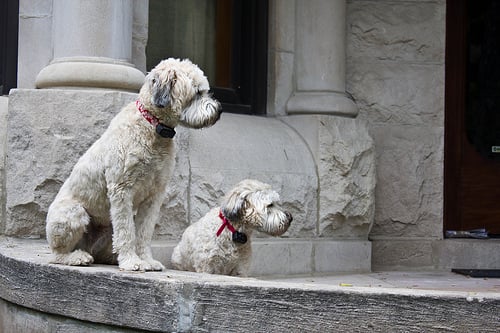Wheaten Terrier Cost
Bred to be an all-purpose farm dog, the Wheaten Terrier, known for its soft coat and hard work ethics, was initially used to herd livestock and hunt vermin over 200 years ago. This breed is alert, confident and will thrive on a lot of physical activity, making it a wonderful choice for active families.
Almost extinct in the early 1930s, they were saved by the dog fancier, Patrick Blake.
Wheaten Terrier puppies cost
The cost of a Wheaten Terrier puppy, as with adopting any puppy, will depend on the breeder you’re working with, their reputation, geographical location, and the dog’s quality, age, health and the supply/demand. From our research, the costs for a puppy around 8-10 weeks old can greatly range anywhere from $850 to $2,350. A purebred, AKC registered puppy will often be in the $1,800 to $2,200 range, while a dog with the appropriate paperwork but no AKC registration can cost about $800 to $1,200.
On PuppyFind.com, for instance, a popular dogs-only classified ad website, had more than 100 listings, with prices ranging from $850 to $2,200.
The AKC Marketplace had more than 50+ breeders listed, with a fair majority offering puppies up for adoption. According to the listings we looked at, the majority were selling their puppies for about $1,900 to $2,200.
At NextDayPets.com, another classified website similar to PuppyFind.com, had multiple listings ranging from $1,000 to $1,500.
What should be included in the adoption?
Any reputable breeder, at a minimum, should include the registration paperwork, up-to-date vaccinations, a vet examination, health certificate, a health guarantee and a travel crate if being shipped. Some breeders, especially those selling an AKC registered puppy, will often include a microchip, dew claw removal, deworming and the recommended health tests, including a hip evaluation, eye exam, bloodwork, CBC and a UPC/Microalbumin (MA) test.
Description
| Energy | Can be somewhat active depending on the cirumstances |
| Good with children? | Tends to do better with older children |
| Good with other pets? | Yes, with supervision |
| Grooming | Recommended brushing twice a week, with bath/grooming every four weeks |
| Height | 18-20 inches for both males and females |
| Life Expectancy | 12-15 years |
| Personality | Cheerful, affectionate, caring and very loyal to its owner |
| Shedding | Little to none, making it a great choice for those who suffer with allergies |
| Weight | 35-41 pounds for male, with females smaller at 30-36 pounds |
Temperament
The Wheaten Terrier is known to be caring, friendly, active, bright, cheerful, animated and makes for a wonderful companion at home, for both adults and older children. As it was bred to be working dog, it still instills that hardworking trait, always wanting to please its owner. Due to the effort it requires, it’s recommended for experienced dog owners with basic training knowledge.
The coat
The coat, being the most distinguishing featuring, is medium in length, soft, silky and sort of wavy. Even though it is a single coat breed, the hair will continue to grow, providing it with insulation and protection. While the puppies will be born with a black coat, it will slowly transform into a gold to reddish-gold or silver.
Tips to know
Even though the dog is known not to shed, they will still need a frequent brushing to keep its coat in tip-top shape.
Though the dog is billed as being “hypoallergenic,” you have to remember that there’s no such thing as this term as all dogs will naturally produce some sort of dander. While this dog will not shed heavily in comparison to other breeds, some people can find themselves being allergic to more than just the dander and hair. If you or even a family member are allergic to dogs, then it’s recommended you spend time with a dog you’re thinking about adopting for some time to see if your allergies act up.
They were recognized by the AKC in 1973, and the AKC will only recognize the Soft Coated Wheaten Terrier Club of America as the official Parent Club for the Soft Coated breed.
Recommended health tests by the official breed club include a hip evaluation, ophthalmologist evaluation, blood chemistry panel, CBC, urinalysis and a UPC/Microalbumin (MA) test. The SCWTCA did note veterinarians have identified three possible conditions which occur at a much higher rate for this breed: protein-losing nephropathy, protein-losing enteropathy and renal dysplasia.
This breed can do quite well in small living spaces such as an apartment; however, as these dogs are moderately active, a daily walk is highly recommended. If fenced in, they are clever and can find a way either over or under the fence, so you need to make sure this fence setup is as secure as possible.
Like most Terries, they are pretty quick to sound the alarm at any foreign sound they hear.
Needing a great amount of attention, if left alone for long periods of time, they can suffer from separation anxiety, which, unfortunately, leads to destruction and/or excessive barking.
They love to jump, especially on strangers.
Advertising Disclosure: This content may include referral links. Please read our disclosure policy for more info.

Average Reported Cost: $0




